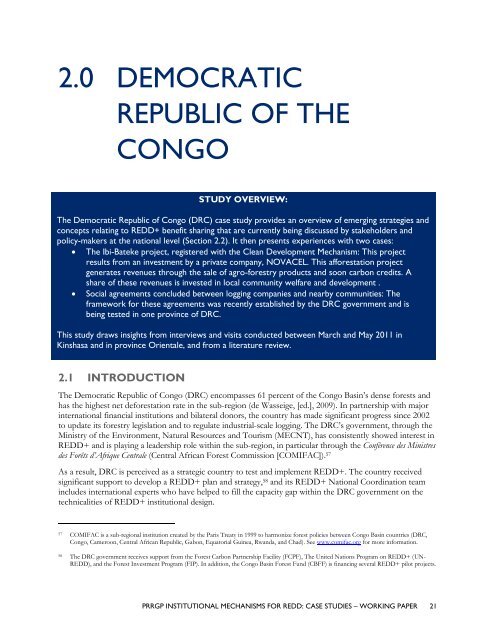Institutional Mechanisms for REDD+ - Case Studies Working Paper
Institutional Mechanisms for REDD+ - Case Studies Working Paper
Institutional Mechanisms for REDD+ - Case Studies Working Paper
Create successful ePaper yourself
Turn your PDF publications into a flip-book with our unique Google optimized e-Paper software.
2.0 DEMOCRATIC<br />
REPUBLIC OF THE<br />
CONGO<br />
2.1 INTRODUCTION<br />
STUDY OVERVIEW:<br />
The Democratic Republic of Congo (DRC) case study provides an overview of emerging strategies and<br />
concepts relating to <strong>REDD+</strong> benefit sharing that are currently being discussed by stakeholders and<br />
policy-makers at the national level (Section 2.2). It then presents experiences with two cases:<br />
� The Ibi-Bateke project, registered with the Clean Development Mechanism: This project<br />
results from an investment by a private company, NOVACEL. This af<strong>for</strong>estation project<br />
generates revenues through the sale of agro-<strong>for</strong>estry products and soon carbon credits. A<br />
share of these revenues is invested in local community welfare and development .<br />
� Social agreements concluded between logging companies and nearby communities: The<br />
framework <strong>for</strong> these agreements was recently established by the DRC government and is<br />
being tested in one province of DRC.<br />
This study draws insights from interviews and visits conducted between March and May 2011 in<br />
Kinshasa and in province Orientale, and from a literature review.<br />
The Democratic Republic of Congo (DRC) encompasses 61 percent of the Congo Basin‘s dense <strong>for</strong>ests and<br />
has the highest net de<strong>for</strong>estation rate in the sub-region (de Wasseige, [ed.], 2009). In partnership with major<br />
international financial institutions and bilateral donors, the country has made significant progress since 2002<br />
to update its <strong>for</strong>estry legislation and to regulate industrial-scale logging. The DRC‘s government, through the<br />
Ministry of the Environment, Natural Resources and Tourism (MECNT), has consistently showed interest in<br />
<strong>REDD+</strong> and is playing a leadership role within the sub-region, in particular through the Conférence des Ministres<br />
des Forêts d’Afrique Centrale (Central African Forest Commission [COMIFAC]). 57<br />
As a result, DRC is perceived as a strategic country to test and implement <strong>REDD+</strong>. The country received<br />
significant support to develop a <strong>REDD+</strong> plan and strategy, 58 and its <strong>REDD+</strong> National Coordination team<br />
includes international experts who have helped to fill the capacity gap within the DRC government on the<br />
technicalities of <strong>REDD+</strong> institutional design.<br />
57 COMIFAC is a sub-regional institution created by the Paris Treaty in 1999 to harmonize <strong>for</strong>est policies between Congo Basin countries (DRC,<br />
Congo, Cameroon, Central African Republic, Gabon, Equatorial Guinea, Rwanda, and Chad). See www.comifac.org <strong>for</strong> more in<strong>for</strong>mation.<br />
58 The DRC government receives support from the Forest Carbon Partnership Facility (FCPF), The United Nations Program on <strong>REDD+</strong> (UN-<br />
REDD), and the Forest Investment Program (FIP). In addition, the Congo Basin Forest Fund (CBFF) is financing several <strong>REDD+</strong> pilot projects.<br />
PRRGP INSTITUTIONAL MECHANISMS FOR REDD: CASE STUDIES – WORKING PAPER 21

















